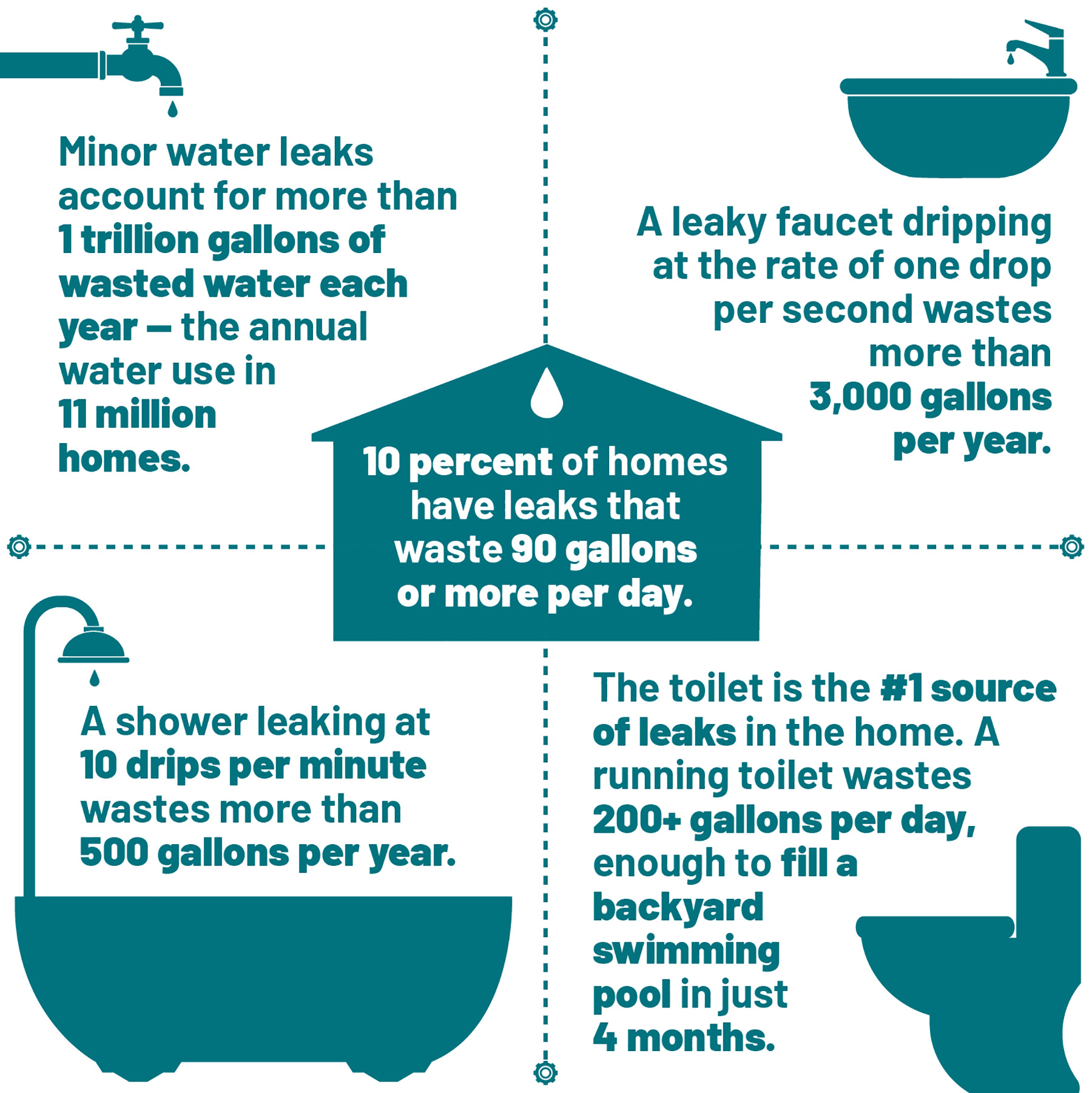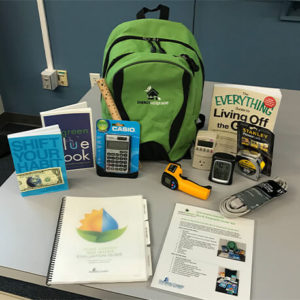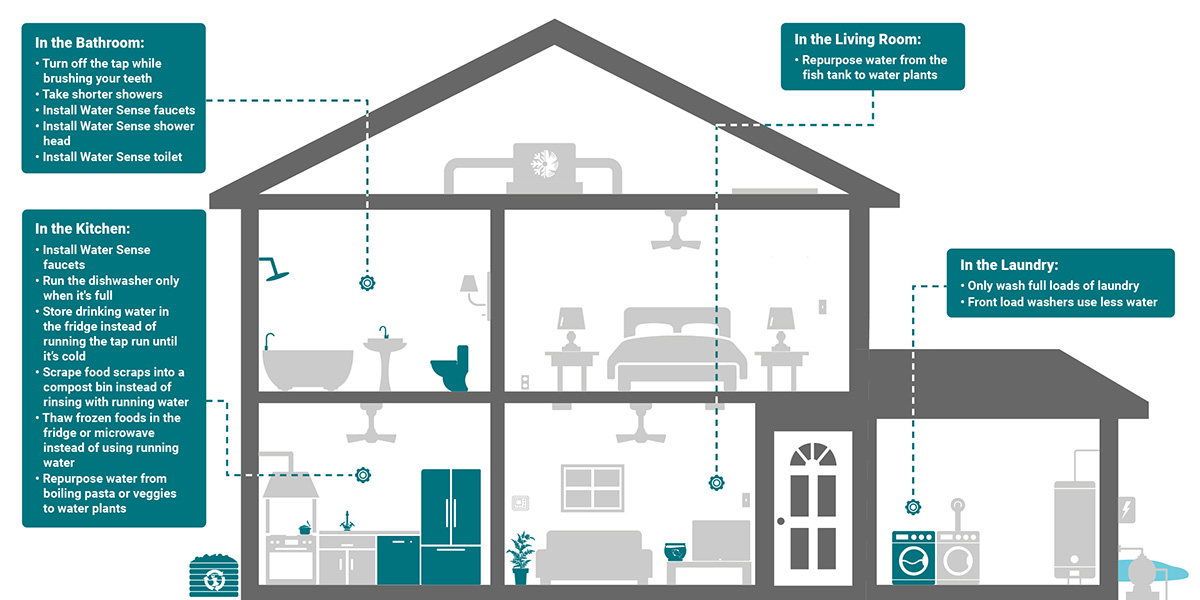Be Water-Wise
How often do we take clean flowing tap water for granted? A seemingly unlimited supply is piped directly into our homes for less than a penny per gallon. Even Florida, the land of liquid sunshine, is facing a thirsty future with population growth doubling water use by 2070. Using water wisely begins at home, with simple actions like repairing plumbing leaks, upgrading to water-saving fixtures and appliances, and adopting everyday conservation and disposal practices that become lifelong habits. Minimal up-front investments will pay immediate dividends in lower water bills.

We’ve sifted through all sorts of water saving tips to find the ones that are easiest and most effective. In many cases, the solutions are free—you just make a small tweak to the way you do things. There are also many low-cost solutions that only require a quick trip to the home improvement store.
Cost: $0-20
Drip, drip, drip. That sound is annoying and it’s costing you money. Leaks add about 10% more to your water bills.

Fixing leaks is one of the easiest, cheapest, and most effective ways to save water. You won’t even need a plumber to find and fix many common household drips—just a quick trip to the hardware store!
Check out this round-up of DIY video tutorials collected by the EPA Water Sense program that show you how to fix toilet, faucet, showerhead, and outdoor irrigation leaks yourself!
 Handy homeowners can check out Sarasota County’s free Do-It-Yourself (DIY) Assessment Kits, available at Sarasota County Libraries. The Kit provides tools and a step-by-step Home Water Evaluation Guide for analyzing your household water use and identifying ways to save. Visit the library catalogue to reserve your kit for pickup at a library near you.
Handy homeowners can check out Sarasota County’s free Do-It-Yourself (DIY) Assessment Kits, available at Sarasota County Libraries. The Kit provides tools and a step-by-step Home Water Evaluation Guide for analyzing your household water use and identifying ways to save. Visit the library catalogue to reserve your kit for pickup at a library near you.
WATCH: How To Use the DIY Home Water Evaluation Kit
Cost: $5-500
It’s good to be a gadget geek when it comes to conserving water. Using water saving fixtures can reduce indoor water usage by 20%.
Installing faucet aerators, low-flow shower heads, dual-flush toilet tanks, and motion-sensor faucets is a smart move. Look for products with the WaterSense label indicating they meet or exceed the performance of standard models and save at least 20% more water. Or try this DIY hack for creating a low-flow toilet.

Local governments, including Manatee County and the City of Venice, often offer rebates of up $100 to replace water-wasting toilets in older homes.
Step it up by investing in water-stingy washing machines and dishwashers. Certified Energy Star appliances conserve both water and energy. An Energy Star washing machine can reduce your energy costs by 33% and cut your water costs by more than 50%. Efficient hot water delivery systems that reduce the wait for water to get hot are another smart investment that recoups installation costs over time. Check out gently used appliances at Habitat ReStore.
Cost: Free
Mindfulness matters when it comes to water conservation. Changing your own behavior, even in small ways, delivers big results. Modern plumbing fixtures and appliances definitely reduce water use but turning off the tap is just as important.
Watering the average-sized lawn 20 minutes every day for a week is like taking 800 showers. Cut out the grass to cut your water use outdoors and tune-up your irrigation system with timely repairs, drip irrigation, and rain sensors.
Food has a huge water footprint. In the U.S., 80 percent of all water consumed is used in agriculture, which means the largest portion of your water footprint comes from your diet. To save water, eat lower on the food chain, eat less processed foods, and minimize food waste.
It takes water to make electricity and fuel, and it takes energy to move, heat, and treat water, so saving energy saves water.
Everything you buy, use, and throw away takes water to process and transport. Use less by making thoughtful purchases and reusing and recycling more.

 What’s My Water Footprint?
What’s My Water Footprint?From showers to shopping and flushes to food, it can really add up. Use this calculator to itemize your family’s direct and indirect water use habits and see which account for the most water use. You’ll be surprised! Compare your daily water footprint to the national average.
The fresh water that’s piped into your house for drinking and washing is also used to flush your sewage out. But it’s not all smooth sailing once you flush. Backups, leaking pipes, and failing septic tanks can connect our plumbing through groundwater and stormwater to our bays and beaches, contaminating them with raw or partially treated sewage. Protecting water also means curbing water pollution—because it’s all the same drops.
Here’s what you can do to keep sewage out of our waters.
Many municipal sewage overflows are caused by blockages and backups due to consumer trash in the pipes. They may seem harmless and the package may even say “flushable,” but things like cotton swabs, cigarette butts, tampons, condoms, and wipes are not flushable! Fats, oils, and grease down the kitchen sink also cause backups. The only things that should ever be flushed down the loo are pee, poo and toilet paper!
Regular septic maintenance and care saves costly repairs and helps curb pollution. Find a licensed septic system contractor and follow these steps:
Make sure your lateral sewer line is in good shape; this is the sewer pipe that runs from your home to the street and connects to the central sewer system. Your lateral line is your responsibility. Contact a plumber if you notice any of these symptoms of cracks, tree roots, or separated pipe joints:
Houses built before 1975 are more likely to have sewer lines made of outdated materials that are prone to leaks and cracks. Consider having a plumber or home inspector perform a camera scope inspection. A minimal investment of a few hundred dollars could save you major repairs costing thousands.
The Florida House is a water-and-energy conserving demonstration house in Sarasota, Florida that showcases water efficient technologies. Location: 4454 South Beneva Road.
Find out what’s happening and join in with our comprehensive community events listing.
Look for these classes
The #1 water waster in your home is the toilet. A leaking toilet can waste 15,000 gallons of water a month. To check if your toilet has a leak, place several drops of food coloring in the toilet tank. If the color seeps into the toilet bowl within 30 minutes without flushing, your toilet has a leak. Water efficient toilets use 1.5 to 2 gallons per flush; older models can use up to 8 gallons per flush. Newer toilets cut total indoor water usage by 30%. Leaks in your home can also squander lots of water and leave your wallet lighter. A leak the size of a pinhead can waste 360,000 gallons of water a year. That is enough water to fill 20 average sized backyard pools.
You can help prevent overflows of raw or partially treated wastewater by being careful about what you flush down the toilet (only pee, poo and paper!); reducing your water use during heavy rains (avoid running dishwashers and washing machines); and keeping kitchen greases and oils out of your drains. If you have an older home, consider having a camera scope inspection to make sure the pipe from your home to the street (your sewer lateral) isn’t cracked or damaged by tree roots.
The water from your home faucets is pumped from below-ground aquifers or area reservoirs. It is highly treated, tested and monitored according to strict federal safety standards, and piped directly to your home for pennies a gallon.
In contrast, bottled water is often just repackaged tap water with a much higher price tag. Its environmental and energy cost is high too. The plastic bottle requires drilling for oil, shipping the oil to a port, trucking it to a refinery, manufacturing the bottle, and shipping it to stores. Then you use more energy driving to your local market to buy it and refrigerating it at home. Only a fraction of plastic bottles will be recycled; most wind up in landfills or end up adding to the plastic pollution problem in our bays or the ocean where they will break down into tiny pieces known as microplastics that are ingested by seabirds, turtles, dolphins and manatees.
Here are 10 steps you can take to improve the sustainability of your business:
By setting specific goals and implementing targeted initiatives, you can make meaningful strides towards sustainability while working towards becoming a Sarasota County Green Business Partner.
Submit your water-related question to local experts. If selected, they will answer and feature your question on our FAQ. Not all questions will be answered. Please note that customer service questions should be directed to your utility provider.
This site protected by reCAPTCHA and the Google Privacy Policy and Term of Service apply.
©2025 Science and Environment Council of Southwest Florida | Site by Chariot.